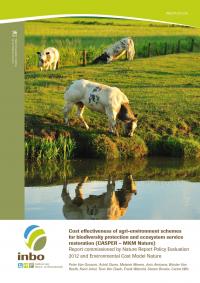Gedaan met laden. U bevindt zich op: Cost effectiveness of agri-environment schemes for biodiversity protection and ecosystem service restoration
Cost effectiveness of agri-environment schemes for biodiversity protection and ecosystem service restoration
This report examines whether the current measures for ‘meadow birds’ can be optimized. The wader measures are in essence a postphonement of the current agricultural mowing and grazing practice. This postphonement increases the survival of brood and young chicks, so that the meadow bird populations can maintain or expand. However, the postphonement has a negative effect on the economic return for the farmer. Farmers are compensated for this by the government through management agreements. So there is a trade-off between promoting the wader population and agricultural yield. Tradeoff that lends itself to the following optimization questions: "How can we with a certain government budget that is used to compensate farmers for income losses, boost up meadow bird populations in the Northern
Campine region?". An alternative question might be: "How can a specific target for meadow www.inbo.be Cost effectiveness of agri-environment schemes for biodiversity protection and ecosystem service restoration (CASPER – MKM Nature) 9 bird populations in Flanders reach with a minimum yield losses in agriculture and thus a minimal government budget to compensate farmers?".

Lees de publicatie
- Publicatiedatum
- December 2012
- Publicatietype
- Onderzoeksrapport
- Thema's
- Natuur en bos
- Auteur(s)
- Peter Van Gossum, Astrid Sturm, Melanie Mewes, Joris Aertsens, Wouter Van Reeth, Karin Johst, Toon Van Daele, Frank Wätzold, Steven Broekx, Carine Wils
- Reeks
- INBO.R.2012.53